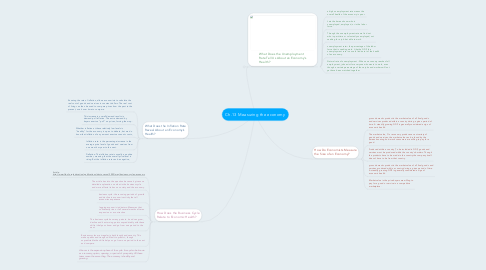Ch.13 Measuring the economy
by Amy Saldana

1. What Does the Unemployment Rate Tell Us About an Economy’s Health?
1.1. a high unemployment rate means the overall health of the economy is poor.
1.2. Lets the bureau know who is unemployed, employed, or in the labor force.
1.3. Through the unemployment rate we find out who is part-time or voluntarily unemployed, not seeking for a job but able to work.
1.4. unemployment rate—the percentage of the labor force that is seeking work. Like the GDP, the unemployment rate is a useful indicator of the health of an economy.
1.5. Natural rate of unemployment - When an economy reaches full employment, jobs exist for everyone who wants to work, even though a certain percentage of those jobs and workers will not yet have been matched together.
2. What Does the Inflation Rate Reveal About an Economy’s Health?
2.1. Knowing the rate of inflation, allows economists to calculate the real cost of goods and services in constant dollars. The real cost of living can then be used to compare prices from the past to the present, use it over time to compare.
2.2. This increase in overall demand results in demand-pull inflation. The extra demand by buyers exerts a “pull” on prices, forcing them up.
2.3. Whether inflation at these relatively low levels is “healthy” for the economy is open to debate, but we do know that inflation of any amount exacts economic costs,
2.4. Inflation rate- is the percentage increase in the average price level of goods and services from one month or year to the next.
2.5. Deflation- The inflation rate is usually a positive number, meaning that the overall price level is rising. But the inflation rate can be negative,
3. How Does the Business Cycle Relate to Economic Health?
3.1. Article: http://www.frbsf.org/education/publications/doctor-econ/2002/may/business-cycles-economy
3.2. The article ties into the question because it gives us a detailed explanation on what is the business cycle and more effects its has on society and the economy.
3.3. business cycle -the recurring periods of growth and decline in economic activity that all economies experience.
3.4. lagging economic indicators-Measures that consistently rise or fall several months after an expansion or a contraction
3.5. The business cycle has many parts to it and can grow, decline and has turning points unpredictably with these shifts it helps us know and go from one period to the next.
3.6. Business cycles are irregular in both length and severity. This makes peaks and troughs difficult to predict., though unpredictable the shifts helps us go from one period to the next and compare.
3.7. A boom is the expansion phase of the cycle. It may also be known as a recovery, upturn, upswing, or period of prosperity. All these terms mean the same thing. The economy is healthy and growing.
4. How Do Economists Measure the Size of an Economy?
4.1. gross domestic product is the market value of all final goods and services produced within a country during a given period of time. A steadily growing GDP is generally considered a sign of economic health.
4.2. The market value, Our economy produces a vast variety of goods and services, the market value can be found by the bureau knowing how much consumers are willing to pay for a good.
4.3. Produced within a country ,To be included in GDP, goods and services must be produced within the country’s borders. Though the products have to be made in the country the company itself doesn't have to be from that country.
4.4. gross domestic product is the market value of all final goods and services produced within a country during a given period of time. A steadily growing GDP is generally considered a sign of economic health.
4.5. Market value is the price buyers are willing to pay for a good or service in a competitive marketplace.


